|
Los Angeles is a global city that hosts dozens of internationally renowned museums. These institutions project their character and influence to the world through their websites. This page will examine how successfully three local museums convey their message online.
The Getty
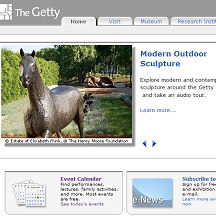 OVERVIEW
Getty.edu is the official face of six entities: Getty Center, Getty Villa, Getty Research Institute, Getty Conservation Institute, the Getty Foundation and the Getty Trust. The Getty’s collections specialize in European antiquities. Overall, the Getty’s website is easy to use, quick to navigate and offers comprehensive information about the organization.
NAVIGABILITY
The front page features a slideshow news box announcing upcoming events. Colorful icons punctuate the clean white and gray color palette while the tabbed navigation bar efficiently condenses dozens of paths into a simple menu. Each tab contains sub-menus that offer drop-down lists. Visitor information for The Getty Center in Los Angeles and The Getty Villa in Malibu are side-by-side on the same page.
CONTENT
The Getty’s focus on art, history and education is highlighted through the site’s extensive libraries. The site hosts a searchable gallery of photographs, videos and articles to augment the physical museum.
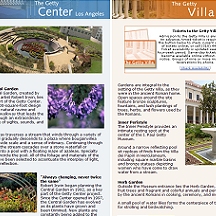 FEATURES
The images posted throughout the site demonstrate the collection’s diversity and the museum’s uniqueness. Video tours of both Getty campuses explore art, architecture and history. Public lectures, conferences and project videos are downloadable. GettyGames offers visitors challenging on-line activities that are fun and educational. While the interface is targeted to children, the detail-oriented matching and detective games are enjoyable for people of all ages.
STORE
The Getty Online Store sells books, posters and gift items from the Getty Villa. The inventory is searchable and browsing is simple.
LINKS
“Useful Links” located along the bottom of the page are inconveniently located and direct users to redundant areas of the site.
SCORE: 4/5
Griffith Observatory
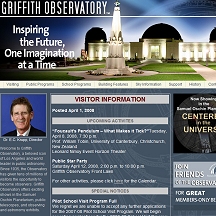
OVERVIEW
The Griffith Observatory is an iconic facet of Los Angeles in the public imagination. The Observatory recently underwent a massive renovation. Similarly, their website reflects the same spirit of constant improvement, education and technology. Overall, Griffithobs.org is a professional, user-friendly webpage.
NAVIGABILITY
The drop-down menus along the bottom of the header are intuitive and the content organization is simple.
CONTENT
The site’s content is thorough and informative regarding all aspects of the Observatory. Information is organized to target those audiences who use the site most. Specifically, a section called “School Programs” informs fifth grade teachers of the opportunities available at the Observatory in a Pilot School Visit Program. Pertinent material includes schedules and prices for shows at the Samuel Oschin Planetarium and menus from the Café at the End of the Universe.
FEATURES
A “Virtual Tour” displays Quicktime 360-degree views of the entire main building before the renovation, right down to the bathrooms. Photographs document exhibits and telescopes. For example, the Hall of the Eye section walks through an observatory wing and describes features such as the Tesla Coil and models of other historic California telescopes.
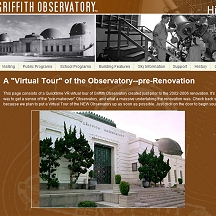
STORE
The Stellar Emporium offers a “cosmic array” of astronomy-themed gifts, books, clothing, toys and other items. The store is user friendly, offering clear navigation along the left side of the page for purchases appealing to adults and children.
LINKS
Links to external pages are scattered throughout the site. For example, the “Sun/Moon/Planets” page under the “Sky Information” menu includes links to the U.S. Naval Observatory. It appears that all links are functional and current.
SCORE: 3.75/5
The Los Angeles County Museum of Art
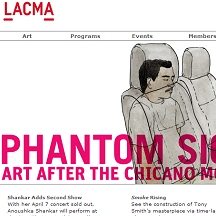
OVERVIEW
LACMA.org is the Internet home of the Los Angeles County Museum of Art. The site exudes excellence.
NAVIGABILITY
Like Getty.edu, the site is mostly white and gray with judicious splashes of color. However, the front page exemplifies the site’s crisp contemporary ethic that is carried throughout. A horizontal navigation bar at the top of the page uses drop-down menus that appear when the user mouses over the headings. These menus are well thought out, but visitor information is buried under the “General Info” tab when it could be more visible. The drop-down menus are supplemented by navigation options on the left side of the page.
CONTENT
The site’s content is complete and relevant to the museum’s mission. For example, “Behind the Scenes” contains a remarkable compilation of articles and essays with pictures of LACMA. Further, collections and on-line exhibitions with accompanying glossaries are useful resources. Visitor information including events, maps, cost and location of parking and restaurants is prominent.
FEATURES
The site hosts an archive of video and podcasts to compliment a library and its online collections. A plentiful variety of images are utilized, but some are small and cannot be enlarged. Progress of the museum’s expansion is broadcast live via a high-quality webcam. Look-and-listen audio tours are available free through LACMA’s NexGen program for kids. NexGen also hosts a game called Families & Children in American Art that involves discovering details within a piece of art and clicking on white boxes to learn more about the work and its history. However, the music and sound effects are intrusive. All NexGen materials are available in English and Spanish.
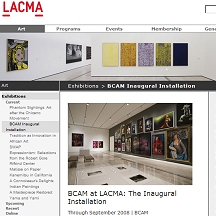
STORE
LACMA sells memberships, event tickets and merchandise. Links to join and buy are a fixture of the left-side navigation. The membership and ticketing information is easily accessible and navigable. However, the merchandise page is disjointed and confusing. Moreover, some products do not include prices in the description. Consistent with the rest of the site’s images, some pictures are not expandable.
LINKS
The Provenance Research Project was established by LACMA to conduct research in accordance with the Guidelines of the American Association of Museums (AAM) Concerning the Unlawful Appropriation of Objects During the Nazi Era. The Project page contains links to Holocaust Era sites, other museums and lost object registrations.
SCORE: 4.5/5
|




